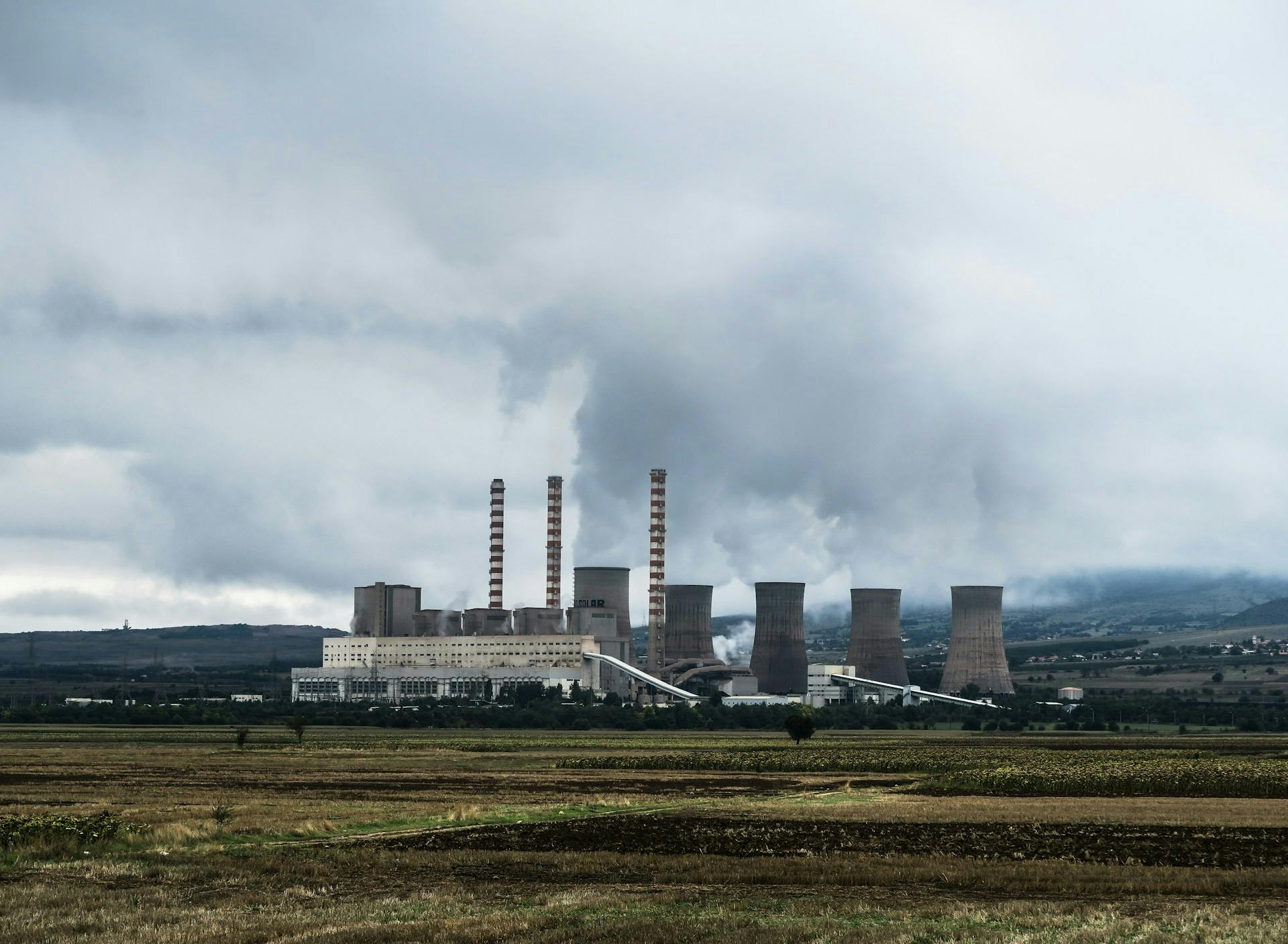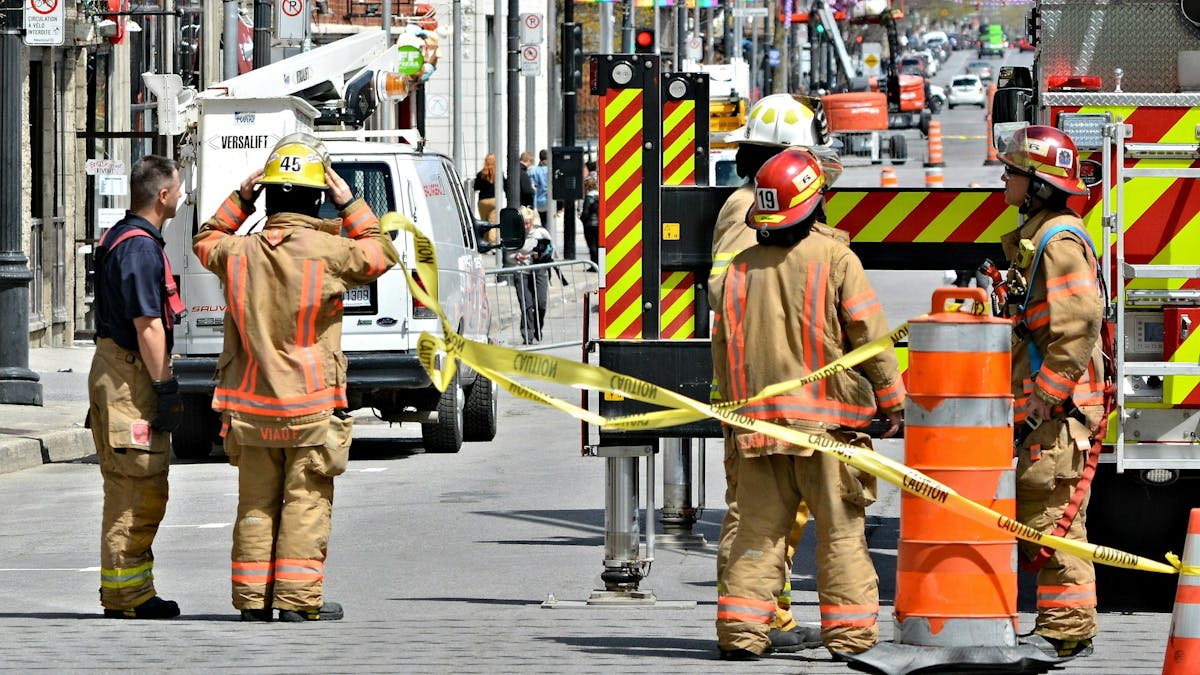4 Types of Disasters Every Facility Must Prepare For


When disaster strikes an industrial facility, every second counts. The distributed nature of non-desk workers creates unique vulnerabilities during emergencies—they can't simply check their email for updates or instructions.
As extreme weather events increase in frequency and severity, technological systems grow more complex, and threats evolve. That’s why facility managers must prepare for 4 types of disasters to protect both people and operations.
A comprehensive disaster preparedness plan helps ensure worker safety and minimize operational disruptions during crisis situations, which is critical for enhancing workplace safety.
The 4 Facility Disaster Types
As a facility manager, you need to prepare for four main types of disasters: natural, technological, human-induced, and hazardous material incidents. Taking a balanced approach that addresses all four categories prevents leaving your facility vulnerable.
Disasters rarely happen in isolation. For example, a hurricane can cause power outages, leading to technological failures. A technological malfunction could result in a hazardous material spill. This interconnected nature of disasters highlights the need for comprehensive preparedness.
While each disaster type requires specific response strategies, they all benefit from rapid, reliable communication systems. This is especially important for non-desk workers who face particular challenges during emergencies due to their:
- Distribution across large areas or multiple locations
- Limited access to computers or company networks
- Work in noisy environments where alarms might go unheard
- Exposure to conditions requiring immediate evacuation or shelter-in-place actions
These factors create a need for specialized communication solutions that can reach all workers quickly and reliably, regardless of their location or access to technology.
Natural Disasters: Essential Planning for Facilities
Natural disasters pose significant threats to industrial facilities, potentially causing devastating impacts on both human safety and business operations. As one of the 4 types of disasters a facility should plan for, natural disasters require thorough preparation.
Types and Impacts of Natural Disasters
Hurricanes and tropical storms combine multiple destructive elements, including storm surge flooding, high-speed winds, and heavy rainfall. Additionally, flooding affects industrial facilities across all geographical regions, occurring from various causes such as flash floods, river flooding, and coastal flooding. Just one inch of water can cause approximately $25,000 in damage to a facility.
Extreme weather events like severe heat and thunderstorms present additional challenges. Heat exhaustion risks increase for workers performing physical labor, while equipment malfunctions and material integrity issues may arise. Thunderstorms and lightning can damage electrical systems, cause fires, or trigger explosions in facilities handling flammable materials.
Earthquakes pose unique threats, potentially causing structural damage, equipment damage, utility disruptions, and secondary disasters like fires or hazardous material releases.
Preparation Strategies for Natural Disasters
To mitigate these risks, industrial facilities should implement comprehensive preparation strategies:
- Conduct thorough risk assessments for each potential natural disaster.
- Implement structural reinforcements and elevated flooring for critical equipment.
- Install environmental monitoring systems and early warning systems.
- Develop backup power solutions, including generators and battery systems.
- Create comprehensive evacuation plans and conduct regular drills.
- Utilize SMS-based communication systems for rapid alerts and updates.
Effective communication is necessary during natural disasters. Implementing appropriate communication strategies for deskless workers can ensure that important alerts reach all employees promptly. SMS-based platforms can provide alerts about approaching disasters with a 98% read rate, compared to only 20% for email.
The Arkema chemical plant incident during Hurricane Harvey serves as a stark reminder of how natural disasters can trigger secondary industrial disasters. When flooding disabled the facility's refrigeration system, it led to spontaneous combustion of organic peroxides, 21 people requiring medical attention, and forced evacuation of 200 people within a 1.5-mile radius.
Technological Disasters: Preparing for System Failures
Technological disasters are another of the 4 types of disasters a facility should plan for, posing significant threats to industrial facilities by potentially causing widespread disruption to operations, compromising worker safety, and resulting in substantial economic losses.
Common Technological Threats
Power outages are among the most frequent and impactful technological disasters for non-desk environments. When the electricity goes out:
- Production lines grind to a halt
- Automated systems shut down
- Important equipment becomes inoperable
- Climate control in sensitive environments fails
- Safety hazards emerge as emergency lighting and security systems fail
- Data loss occurs if backup systems are inadequate
System failures, particularly in facilities relying heavily on automation and digital management systems, can be equally devastating. These failures may stem from software glitches, hardware malfunctions, or cyberattacks, causing:
- Disruption of inventory tracking and order fulfillment
- Malfunction of robotic systems and automated machinery
- Loss of operational data
- Confusion as workers struggle to switch to manual processes
Equipment malfunctions, while often more localized, can still significantly impact operations. A single piece of faulty machinery in a production line can create a bottleneck that affects the entire facility's output.
Real-world examples illustrate these threats. In February 2021, a major earthquake disrupted the power supply to Toyota chip plants in Japan, forcing a temporary suspension of operations with cascading effects through the global automotive supply chain.
Similarly, in December 2021, an Amazon Web Services (AWS) outage affected Amazon's own logistics network, making processing and shipping orders in much of the U.S. impossible during the run-up to Christmas.
Mitigation and Response Plans
To effectively prepare for and respond to technological disasters, industrial facilities should implement:
- Backup Power Solutions: Deploy Uninterruptible Power Supplies (UPS) and backup generators for important systems.
- Redundant Systems and Failover Protocols: Implement redundant IT infrastructures and failover mechanisms for rapid switching to backup systems.
- Emergency Preparedness and Recovery Plans: Develop detailed disaster recovery and business continuity plans with regular drills.
- Manual Operations Training: Cross-train employees to perform essential tasks manually if automation fails.
- Cybersecurity Investments: Protect against cyberattacks through regular updates, employee awareness training, network segmentation, and access controls.
- Transparent Communication: Establish clear communication channels for informing employees, partners, and customers of disruptions. Emergency notification systems, such as SMS-based communication platforms, function even during power outages or internet disruptions, making them more reliable than email communications during technological disasters.
Human-Induced Disasters: Addressing Internal and External Threats
Human-induced disasters are a significant component among the 4 types of disasters a facility should plan for, posing serious threats to non-desk facilities, ranging from internal risks to external dangers.
Recognizing Human-Caused Threats
Internal threats often come from individuals with legitimate access to the facility:
- Malicious Insiders: Employees or contractors who deliberately cause harm through theft, sabotage, or unauthorized disclosure of sensitive information. For example, a former Cisco employee deleted 456 virtual machines, impacting 16,000 users for two weeks.
- Negligent Insiders: Staff members who unintentionally create security vulnerabilities through carelessness or lack of awareness.
- Compromised Insiders: Employees whose credentials have been compromised by external threat actors.
External threats include:
- Unauthorized Access: Through social engineering, tailgating, or exploitation of outdated access control systems. Facilities with multiple entry points are particularly vulnerable.
- Workplace Violence: Non-desk environments can be especially susceptible due to isolated work areas and high-stress operations.
- Civil Disturbances: Protests, riots, or labor disputes near facilities can disrupt operations and threaten personnel safety.
Cybersecurity threats are increasingly prevalent in non-desk environments:
- Operational Technology (OT) Attacks: As industrial control systems become more connected, they create new attack surfaces with potential physical consequences.
- IoT Device Vulnerabilities: The proliferation of IoT devices in non-desk settings creates additional entry points for cyber attackers.
Preventive Measures and Response Protocols
To safeguard against these threats, facilities should implement comprehensive security protocols:
Access Control Measures:
- Implement role-based access control (RBAC) based on job responsibilities
- Use multi-factor authentication (MFA) for accessing sensitive areas or systems
- Establish visitor management systems for screening and escorting visitors
Human-Focused Security:
- Conduct regular security awareness training
- Establish clear reporting mechanisms for suspicious activities
Physical Security Infrastructure:
- Deploy integrated security systems combining access control, video surveillance, and intrusion detection
- Implement robust perimeter security with physical barriers and monitoring systems
Cybersecurity Protocols:
- Segment operational technology networks from IT networks to contain potential breaches
- Maintain regular system updates, including for industrial control systems and IoT devices
- Implement secure remote access protocols with encryption and authentication
Emergency Response Planning:
- Develop clear procedures for responding to active threats
- Conduct regular drills to familiarize staff with response protocols
Hazardous Material Disasters: Managing Chemical and Biohazard Risks
Hazardous material incidents are one of the 4 types of disasters a facility should plan for, posing significant risks to the health and safety of workers in non-desk environments.
Types of Hazardous Incidents
Chemical spills and biohazard exposures are among the most common and dangerous hazardous material incidents in industrial settings, leading to acute and chronic health issues:
- Toxic fume inhalation can cause immediate symptoms like coughing and dizziness, as well as long-term health problems such as lung damage and cancer
- Skin contact with corrosive chemicals may result in burns, rashes, or systemic poisoning
- Biohazard exposure increases the risk of disease transmission and allergic responses
Studies have shown that non-desk workers are significantly more likely to suffer illness or injury due to hazardous substances compared to their office-based counterparts.
Safety Protocols and Emergency Handling
To effectively manage hazardous material incidents and protect workers, facilities must implement comprehensive safety protocols:
Immediate Isolation and Evacuation
- Quickly isolate the incident area to prevent further exposure
- Evacuate non-essential personnel from the hazard zone
Notification Systems
- Implement rapid alert systems to inform supervisors, safety officers, and emergency responders
- Clearly communicate the nature and scope of the incident
Personal Protective Equipment (PPE)
- Ensure availability and proper use of appropriate PPE
- Conduct regular training on correct PPE usage and emergency donning procedures
Spill Containment Methods
- Deploy spill kits and neutralizing agents specific to the hazardous material involved
- Contain runoff and prevent chemical entry into drains or the environment
Decontamination Protocols
- Establish decontamination zones for affected workers
Medical Surveillance
- Provide immediate medical evaluation for exposed individuals
- Implement ongoing health monitoring following incidents
Incident Investigation and Reporting
- Document the incident thoroughly for regulatory compliance and future prevention
- Conduct post-incident reviews to identify causes and improve response
Regular training and drills ensure all workers can act quickly in an emergency. Tailored safety programs should address the specific hazards present in each work environment.
Moreover, SMS messaging systems can deliver important safety instructions to all affected workers simultaneously, ensuring vital information reaches everyone quickly, even in dispersed or noisy work environments. Utilizing SMS for non-desk employee communication is essential in managing hazardous material incidents effectively.
Leveraging SMS Communication During Disasters
Effective communication is important when dealing with the 4 types of disasters a facility should plan for. SMS-based employee apps have become important communication tools for industrial, non-desk facilities where workers are often dispersed, mobile, and lack constant access to email or intranet systems. Implementing effective communication tips for deskless workers can help overcome these challenges.
Key Advantages for Non-Desk Environments
- Reliability: SMS works on all mobile phones without requiring internet access, making it ideal during disasters when data networks are unreliable
- Immediacy: Messages are typically received within seconds, allowing rapid response and real-time coordination during emergencies
- Accessibility: Employees don’t need special apps or devices—most already carry personal or company-issued phones
- Read Rates: SMS open rates exceed 90%, vastly outperforming email and ensuring important updates are actually seen
- Simplicity: Text messages are easy to understand without training, enabling quick action even in high-stress situations
- Scalability: Messages can be sent to thousands of employees instantly, across locations and departments
These advantages of SMS communication make it an essential tool for emergency preparedness in non-desk environments, especially for companies managing multi-location operations.
Essential SMS Communication Features
- Mass Notifications: Systems support instant broadcasting of messages to thousands of employees or targeted groups
- Segmentation and Distribution Lists: Employees can be grouped by site, shift, role, or language, ensuring messages are relevant and actionable
- Confirmation & Read Receipts: Many systems log delivery and can require recipients to acknowledge receipt
- Frontline Intelligence & Analytics: SMS dashboards provide insights on worksite performance, employee engagement, HR program enrollment rates, and flag high- or low-compliance locations and emerging risk areas based on proactive safety behaviors.
- Two-way Messaging: Employees can respond with their status, request help, or ask questions. For guidance on using SMS for employee alerts, implementing best practices can enhance emergency response.
- Multilingual Support: Messages can be sent in multiple languages to accommodate diverse workforces. Providing emergency alerts in Spanish, for example, ensures all employees understand important instructions
Overcoming Challenges
While SMS-based systems are highly effective, organizations should be aware of potential challenges:
- Network Overload: During large-scale disasters, cellular networks may become congested
- Employee Data Management: Keeping accurate contact information is essential. However, some SMS platforms offer HRIS integrations, you won’t need to manually sync employee data.
- Privacy and Compliance: Systems must comply with privacy laws regarding location tracking and message logging
Developing a Comprehensive Facility Emergency Plan
Creating an integrated emergency plan for different types of disasters is important for facility and employee safety. Start by regularly assessing risks to identify vulnerabilities based on location and operations. Assign response teams for each emergency scenario and establish a clear chain of command.
Ensure evacuation routes and procedures are accessible, especially for employees with disabilities or special needs. Place emergency supplies like first aid kits and communication devices throughout the facility. Use a multi-channel communication approach, including SMS alerts, to reach non-desk workers effectively.
Regular drills, feedback, and scenario-based training will help improve readiness. Implement systems that allow for message segmentation and delivery tracking, and consider integrating with your HR system to keep contact information up to date. Lastly,review your plan annually to ensure continued preparedness.
Safety First: Putting Your Workers' Wellbeing at the Forefront
Preparing for natural disasters, technological failures, human-induced incidents, and hazardous material events is essential for non-desk workplaces. Industrial environments face unique challenges during crises due to their reliance on machinery, physical infrastructure, and a distributed workforce. Without a solid plan and effective communication, even minor disruptions can spiral into serious risks.
That’s why SMS is the most reliable method for emergency communication. With a 98% read rate compared to just 20% for email, text messages cut through the noise and get seen—fast. Yourco’s SMS platform is built for these critical moments. It delivers real-time alerts directly to employees’ phones without needing internet access or app downloads, making it ideal for frontline teams.
During emergencies, Yourco enables you to send evacuation instructions, status updates, and post-disaster information exactly when and where they’re needed. Its two-way messaging allows employees to report their status, ask for help, or confirm safety, while segmentation tools ensure that the right message reaches the right group; whether by location, department, or shift.
What truly sets Yourco apart is its frontline intelligence. By tracking employee interactions with emergency alerts, as well as safety reminders, quizzes, and campaigns, Yourco provides insights into proactive safety behavior. This data helps you identify high- or low-compliance sites and spot emerging risk areas before they become serious problems, allowing for smarter, faster decisions when every second counts.
Try Yourco for free today or schedule a demo and see the difference the right workplace communication solution can make in your company.



